All about pure Maple Syrup
Pure maple syrup is an all natural sweetener. It begins as a clear liquid that can be extracted from a maple tree in the spring.
Coming from a New England farming family, I have often seen maple syrup being made. But not everyone has maple trees native to their area. And not everyone with roots in an area with maples have had the experience of seeing maple syrup being made either.
This post will take you to the front lines 🙂 to show you what it takes to make maple syrup. One of my all time favorite families has given me permission to use their pictures to show you how they work together to make maple syrup for their family and friends.
Let’s start with some basic maple syrup info.
There’s lots to know about maple syrup
Making a syrup from the clear sap of a maple tree was being done by native peoples of the US Northeast and Canada long before the area was known to Europeans or other explorers. The “tools” have changed somewhat but the basic process of how sap becomes syrup hasn’t.
You capture the sap of a maple tree in the spring, when the sap is running, and boil it down into a syrup or a sugar.
BUT
While it’s basically a simple process, making maple syrup takes a LOT of TIME, WORK and PATIENCE. And it’s not an inexpensive venture either.
Maple flavored syrups are a cheap imposter
Grocery store shelves are lined with cheap maple syrup imposters. They go by many names, but only the real thing can be called “Maple Syrup”. When you look at the label of those common imposters, you will note that it never, ever says it is maple syrup, because that is a protected designation.
The label on the imposters will say it is a pancake syrup or a maple flavored something or other. It is usually corn syrup and other additives. It is thick and sweet but nothing like real maple syrup. Real maple syrup may not be considered health food, but it is a lot closer to one than corn syrup with artificial additives.
Real maple syrup is a pure all natural sweetener with nutrients. It has calcium, potassium, riboflavin, manganese and other minerals. Although it is a carbohydrate it a complex carbohydrate which makes it easy for the body to process. It’s right up there with honey when it comes to a health conscious choice for adding sweetness to a beverage, as a topping or in cooking.
How to know the difference
You don’t have to look too far to tell the difference between real maple syrup and the imposers, the price should tell the whole story.
Real maple syrup is not cheap, but it is a bargain given what it takes to get it from the maple tree to a bottle on the grocery shelf.
If you want to make the most of your investment in maple syrup, stay away from the small fancy glass bottles and go for the larger plastic one. In the long run you will save a lot of money. Those fancy little bottles look nice but don’t hold much.
If you want the real thing, make sure the label says it is 100% real maple syrup. The ingredient list will say “maple syrup”. There are no additives, but It has a lot of natural preservatives of it’s own so it lasts a long time.
Things to know about real maple syrup
There are basically 3 graded colors of maple syrup and the color will be stated on the bottle. Light/golden is the lightest color and generally considered the best overall choice. (By the way, I don’t agree with that assessment.) Then there is amber, and dark (or very dark). The darker the syrup the thicker it is with a deeper more robust flavor. I prefer the dark syrups.
Maple syrup is wonderful for cooking both sweet and savory dishes. We have a bread pudding that is made with maple syrup Homemade Bread Pudding and one of our savory dishes with maple syrup is PORK CHOPS APPLES AND ONIONS. Both of them are super good.
Why the difference in colors?
Maple sap when it drips from the tree is clear in color. The sap contains water and a little sugar. When it drips from the tree it only has a hint of sweetness.
The sap turns brown as water evaporates and the sugars are heated to the boiling point. Sap tapped in the early part of the season boils down to a light colored mild tasting syrup. As the season goes on the boiled syrup gets darker and more robust in flavor.
Its kind of nature’s secret why the sap boils down to be different colors. But it seems to be generally accepted that as the nutritional needs of the tree changes when buds are forming on the branches, the sap changes to give the tree what it needs. And those changes cause the differences in the color of the syrup. Nature really is amazing isn’t it?
Because what’s happening in the tree is a natural process, there are no hard and fast rules on such things. Mother nature makes the rules.
So let’s see how it’s done
The Eldridge Family
This post is going to show you how pure maple syrup is made, demonstrated using pictures of one of my favorite families of all time, the Eldridges. They live in Northern New England, tap their trees each year for sap and make their own maple syrup. I say their own maple syrup but many friends and family members share in the bounty after all the hard work is done, me included!
In the pictures you will meet Tim ( Dad #1 there’s 2 in the family now), his wife Jess and their 2 children Ben and Lexie. During the years I have been collecting these pictures the family has grown. Ben married Danielle and they have a beautiful and devilish little boy Dutton. Of course Dutton is now in on the maple syrup action. The Eldridge family does everything together.
In other parts of our site I talk about my gal pal Ann. She has some great recipes. I have shared a couple: PINEAPPLE CREAM and ANN’S ACORN SQUASH, with more to come from her I am sure. Ann is Jess’s mother and we have a close friendship of our own. It’s just my good fortune that she is my ticket to all the big family events. And there are a lot of big family events. That’s what they are all about!
Once a year they collect maple tree sap and boil it down to make maple syrup. Maple syrup time is just one of the many Eldridge family’s big events. 😊
It all starts with sap
Sap is not unique to maple trees, but long ago it was discovered that the sap of a maple makes a delicious syrup when it is boiled down.
Sap season happens in late winter/early spring. In the lingo of those in the know, when the conditions are right, the sap is running.
The sap “runs” according to the natural order of things. It’s not dates on the calendar. It happens when nature decides to put all the necessary conditions together. In order for a maple tree to produce sap, it must have weather conditions of warm days and very cold nights. In northern New England that typically happens February to March.
Tapping the trees for sap
Basically, to collect the sap from a maple tree you bore a hole in the tree trunk of a maple tree and “tap” a spout in. It is referred to as tapping the tree. Then a bucket is hung under the spout to collect the sap that drips out. That is until now. These days even home syrup makers like my Eldridge family attach tubes to the taps so they can collect sap from many trees at one time. That has eliminated the need to trudge through the woods in the snow to go from one tree to another to collect sap, bucket by bucket.
Here’s my best tapping picture. This is my newest picture of Ben and Dani’s son, Dutton. He is getting so big!

Here is little Dutton with drill in hand ready to start tappin’. Such a handsome little guy. He’s looking so grown up.
It’s no wonder Dutton is looking like a pro with his snowsuit, boots and drill.
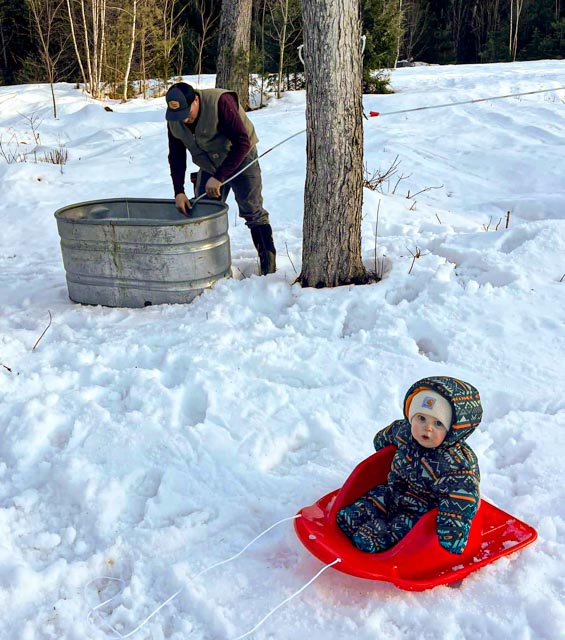
Here’s little Dutton with his Dad, Ben. They started teaching him young. That’s the family tradition.
Collecting the sap
You will see that over the years, while the family has grown so has the equipment they use. The Eldridges love their toys!
You are going to see for yourself why this natural product may be a little pricey. The sap only runs once a year and nothing about the process is easy. It is very labor intensive. Even with the toys.
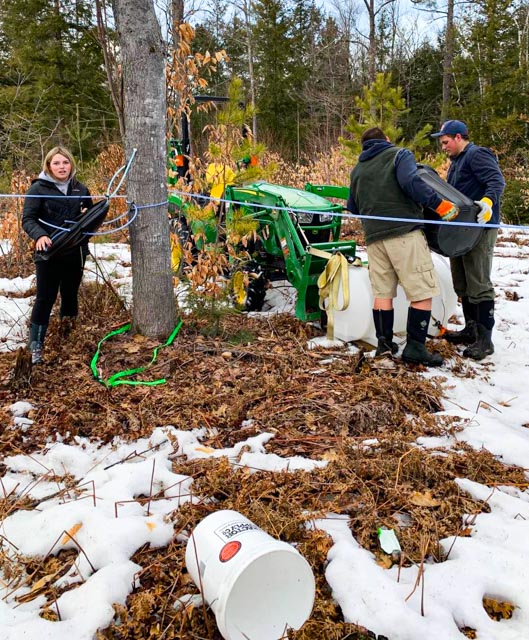
Here we have (from left to right) Lexie, Tim and Ben. Tim is the one in shorts!
As you can see this is not a glamorous chore.
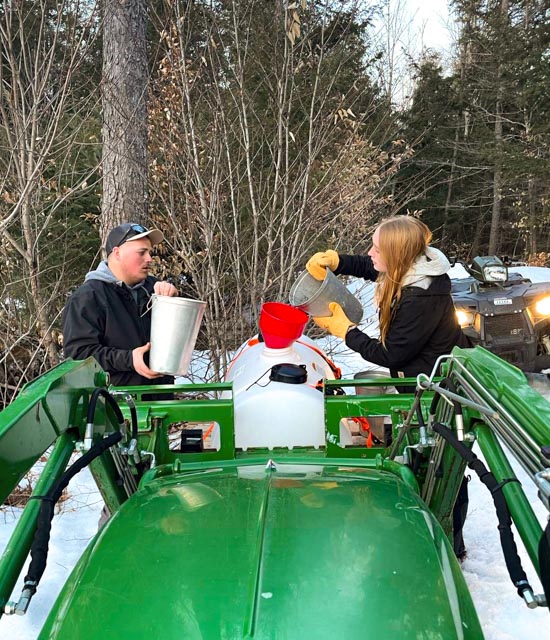
New equipment and new family member. Here’s Ben with his new wife Danielle!
The collection tank must make this chore a lot easier, especially getting the sap into the sap house when it’s full.
Now what?
So now that they have sap, what do they need to do to it to make it into that delicious, thick syrup we love?
If you were making a bucket of sap into syrup at home, you would simply empty the sap into a saucepan and boil it down until it is a thick syrup. With a decent sized bucket of sap and some patience you can make a little bit of syrup. Cook it down until it is the consistency you want it.
Here’s where maple syrup starts costing a lot of $$$$ to make
Those that make maple syrup in volume, whether for personal or commercial use, usually have equipment called evaporators to boil down their sap. Evaporators have a large open pan on top (stainless steel in most cases) that the sap boils in and on the bottom is an area for the fuel source. I am only familiar with evaporators fueled by wood but they can have other heat sources. The evaporator like any piece of equipment needs to be protected from the elements. So the evaporator needs a storage building.
And then, even after the purchase of an evaporator and paying for a building to put it in, every year that you use the equipment to make maple syrup you have to provide enough fuel to keep the syrup boiling for hours and hours and hours. It doesn’t matter what you are using as a heat source, whether it is wood, or propane or electricity we all know that is going to cost a lot of money.
I have only seen evaporators that are fueled by wood and the people I have known that use them use wood they have cut themselves. So although you may say it is less expensive for them to make syrup, what’s saved in cash results in a whole lot of tree cutting and chopping. It makes the already labor intensive project all the more so.
The sap house
Most commonly the evaporator is sheltered in a small cabin like building, referred to as a “sap house”. I have also heard or seen them called sugar houses or sugar shacks. All over northern New England there are neighborhoods with a sap house. Some are open year round selling syrup and other commodities. But many are just buildings large enough to hold the equipment and some seating room and they are only used once a year during sap season.
If you happen to come upon a sap house in the spring, you will know when they are boiling sap by the thick smoke billowing out of the chimney. Generally you are welcome to drop by and watch the process. It gets pretty boring sitting in those little cabins, day after day, feeding wood to the fire, so the occasional drop in guest is rarely turned away.
There are days during sap season that syrup makers collectively open to the public so you can go and watch them making the syrup. They offer tastings. They do this by serving the maple syrup with things like pancakes and ice cream. I even know of a place that boils hot dogs in maple syrup and serves them. A family can go from one sap house to another and try all they have to sample. It is a very “country” family day. You usually have to bundle up to go from one to another because it is cold out, but the sap houses are blissfully warm inside with the heat from the wood burner and the boiling sap.
Each state has it’s own maple syrup maker’s organization that coordinate these open houses, so you can find out more online about open sap houses in any particular state. It’s a fun, fun day with super good free treats!
Back to hands on production
Time to boil the sap
Tim’s sap house is a small building on his property. It is the building shown as the feature shot for the post. He only uses it to process maple syrup.
A couple of years ago he had to buy a new evaporator. The new one also uses wood as the heat source. It’s pretty easy to tell the difference between the old and new one.
Fire up the wood burner, add the sap and boil
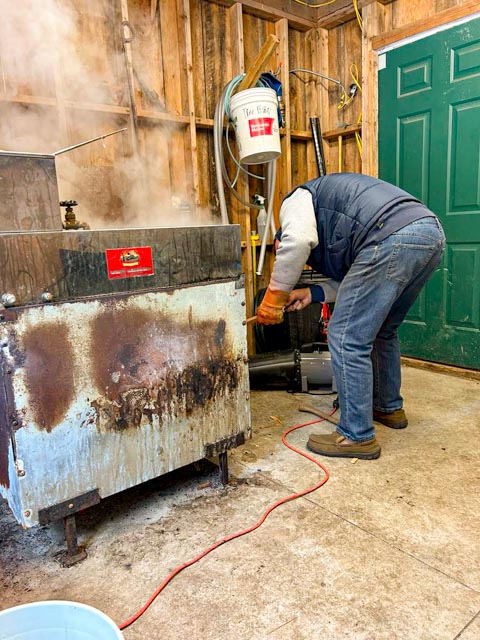
This is Tim tending to the fire in the evaporator’s wood burner.

Tim adding sap to the evaporator’s pan

He’s really got that heat cranking now! Boil baby boil!
And then you wait and stoke the fire, and wait and stoke the fire and….
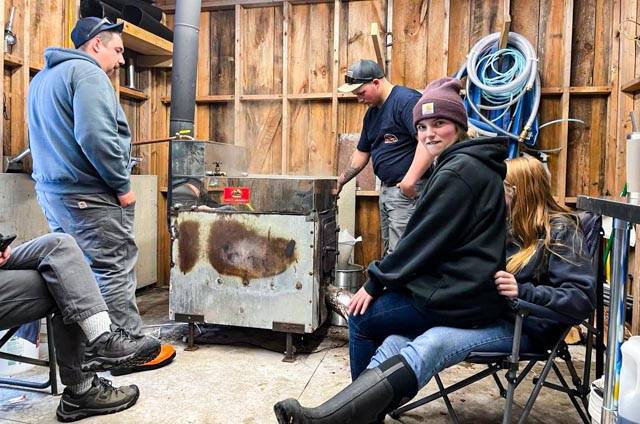
Family and friends gather for the making of the syrup!
New additions to the family
As time marches on things change. In the Eldridge family that means a new evaporator and a new member to the brew crew!
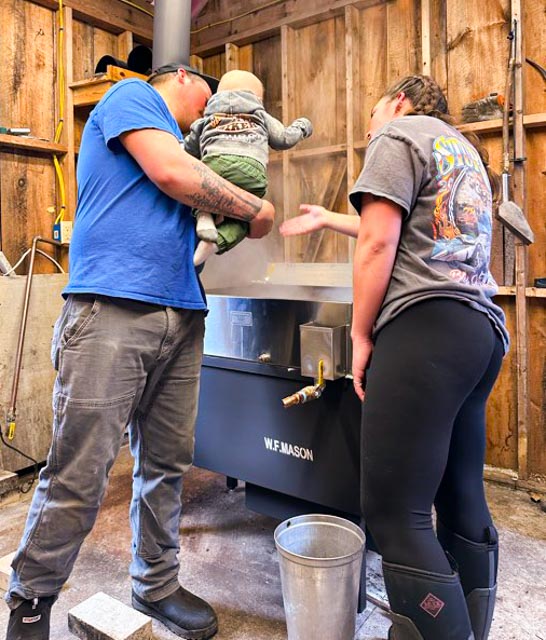
Baby Dutton is getting a good whiff of the maple syrup brewing in the evaporator pan. His Dad Ben and Auntie Lexie are giving him the rundown on what’s going on.
Check out this new evaporator! Nice!
After all that
When the sap has evaporated into maple syrup there is a spigot built into the tray that drains the syrup.
But there is something missing
Jess! In all the pictures I have about making maple syrup, the #1 Mom, Jess is not in any of the pictures. Why? She is usually taking them! But I have a beautiful family shot they had taken not long ago.
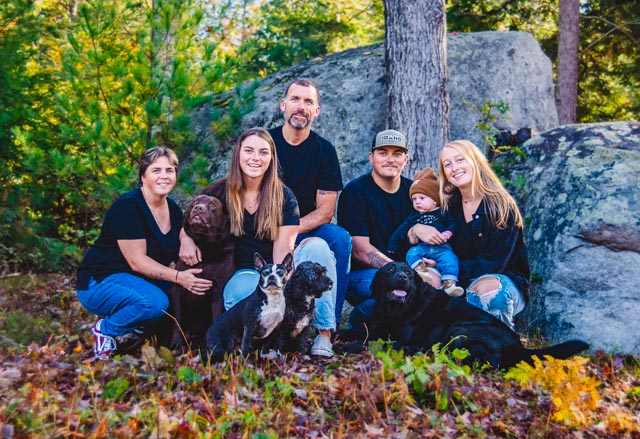
Tim is behind the family in the middle. Then, from left to right: Jess, (and chocolate lab Gus) Lexie, Ben, Dutton and Danielle. And in the front row the other family dogs. Left to right: Ann’s Boston terrier Jazzy, Luna (I can never remember her breed) and in front of Ben is his black lab Trigger.
And why not ….
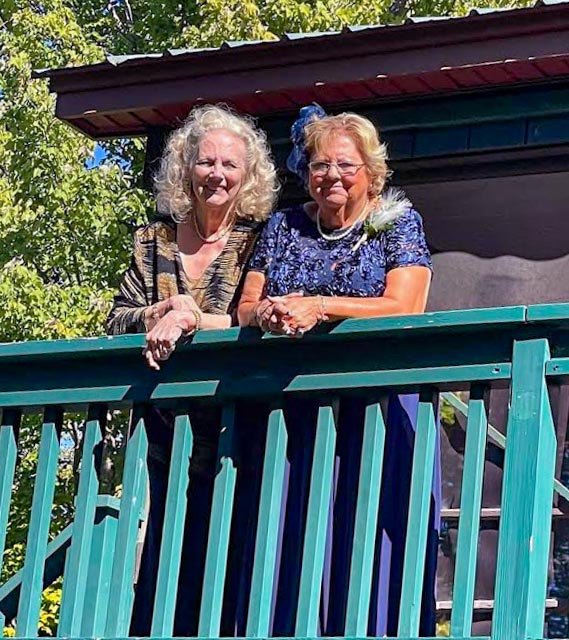
Here’s me and Ann on Ben and Dani’s wedding day. Ann’s the one with the corsage and fancy hat.

